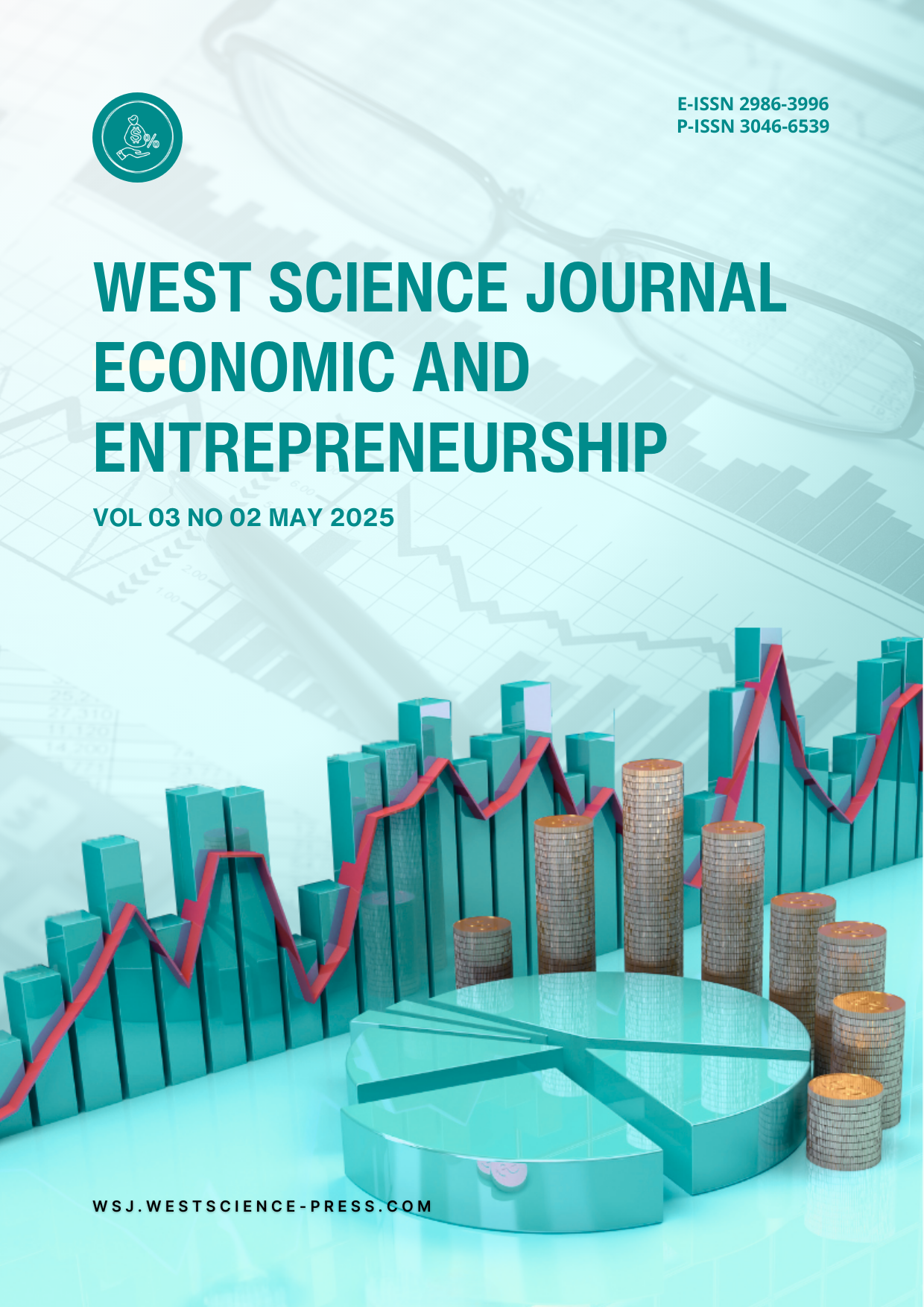Bibliometric Analysis of the Development of Women's Entrepreneurship Literature in Indonesia
DOI:
https://doi.org/10.58812/wsjee.v3i02.1895Keywords:
Women’s Entrepreneurship, Gender, Indonesia, Bibliometric Analysis, VOSviewerAbstract
Women’s entrepreneurship has gained recognition as a critical factor in promoting inclusive economic development, particularly in emerging economies such as Indonesia. This study presents a bibliometric analysis of scholarly publications on women’s entrepreneurship, focusing on trends, thematic structures, and collaboration networks from 2000 to 2025. Using data retrieved from the Scopus database and analyzed through VOSviewer, the study maps co-authorship patterns, co-citation networks, keyword co-occurrence clusters, and temporal evolution of research themes. The findings highlight dominant scholars, countries, and themes such as gender roles, empowerment, entrepreneurial intention, and sustainability. The overlay and density visualizations indicate a growing shift toward system-level and empowerment-related topics in recent years. However, the analysis also reveals underrepresentation of Indonesian research in global discourse. The study concludes by recommending greater international collaboration, diverse methodologies, and deeper contextual engagement to enrich the field and inform effective policy interventions.
References
[1] U. Hani, I. N. Rachmania, S. Setyaningsih, and R. C. Putri, “Patterns of Indonesian women entrepreneurship,” Procedia Econ. Financ., vol. 4, pp. 274–285, 2012.
[2] A. Hendratmi, T. S. Agustina, P. S. Sukmaningrum, and M. A. Widayanti, “Livelihood strategies of women entrepreneurs in Indonesia,” Heliyon, vol. 8, no. 9, 2022.
[3] M. Aria and C. Cuccurullo, “A brief introduction to bibliometrix,” J. Informetr., vol. 11, no. 4, pp. 959–975, 2017.
[4] T. Tambunan, “Women entrepreneurs in Indonesia: Their main constraints and reasons,” A Hist. Dev. Entrep. Cameroon, 2004.
[5] H. Aravik, A. I. Hamzani, and N. Khasanah, “Women Entrepreneurship In Indonesia: Opportunities And Challenges,” Islam. Bank. J. Pemikir. dan Pengemb. Perbank. Syariah, vol. 10, no. 2, pp. 327–348, 2025.
[6] R. P. Setyaningrum, N. Norisanti, M. Fahlevi, M. Aljuaid, and S. Grabowska, “Women and entrepreneurship for economic growth in Indonesia,” Front. Psychol., vol. 13, p. 975709, 2023.
[7] N. Donthu, S. Kumar, D. Mukherjee, N. Pandey, and W. M. Lim, “How to conduct a bibliometric analysis: An overview and guidelines,” J. Bus. Res., vol. 133, pp. 285–296, 2021.
[8] H. Ahl, “Why research on women entrepreneurs needs new directions,” Entrep. theory Pract., vol. 30, no. 5, pp. 595–621, 2006.
[9] C. G. Brush, A. De Bruin, and F. Welter, “A gender‐aware framework for women’s entrepreneurship,” Int. J. Gend. Entrep., vol. 1, no. 1, pp. 8–24, 2009.
[10] A. De Bruin, C. G. Brush, and F. Welter, “Advancing a framework for coherent research on women’s entrepreneurship,” Entrep. theory Pract., vol. 31, no. 3, pp. 323–339, 2007.
[11] C. C. Baughn, B. Chua, and K. E. Neupert, “The normative context for women’s participation in entrepreneruship: A multicountry study,” Entrep. theory Pract., vol. 30, no. 5, pp. 687–708, 2006.
[12] P. B. Datta and R. Gailey, “Empowering women through social entrepreneurship: Case study of a women’s cooperative in India,” Entrep. theory Pract., vol. 36, no. 3, pp. 569–587, 2012.
[13] K. D. Hughes, J. E. Jennings, C. Brush, S. Carter, and F. Welter, “Extending women’s entrepreneurship research in new directions,” Entrep. theory Pract., vol. 36, no. 3, pp. 429–442, 2012.
[14] D. Jamali, “Constraints and opportunities facing women entrepreneurs in developing countries: A relational perspective,” Gend. Manag. an Int. J., vol. 24, no. 4, pp. 232–251, 2009.
[15] W. Piotrowicz and R. Cuthbertson, “Introduction to the special issue information technology in retail: Toward omnichannel retailing,” Int. J. Electron. Commer., vol. 18, no. 4, pp. 5–16, 2014.
[16] M. Lerner, C. Brush, and R. Hisrich, “Israeli women entrepreneurs: An examination of factors affecting performance,” J. Bus. Ventur., vol. 12, no. 4, pp. 315–339, 1997.
[17] M. Noguera, C. Alvarez, and D. Urbano, “Socio-cultural factors and female entrepreneurship,” Int. Entrep. Manag. J., vol. 9, pp. 183–197, 2013.
[18] L. Mulawarman, H. Hasan, and S. M. Sharif, “Motivations and challenges of women entrepreneurs: The Indonesian Mumpreneur perspective,” Eur. J. Mol. Clin. Med., vol. 7, no. 06, p. 2020, 2020.
[19] A. Rafiki and F. N. Nasution, “Business success factors of Muslim women entrepreneurs in Indonesia,” J. Enterprising Communities People Places Glob. Econ., vol. 13, no. 5, pp. 584–604, 2019.
[20] E. Melissa, A. Hamidati, M. S. Saraswati, and A. Flor, “The Internet and Indonesian women entrepreneurs: Examining the impact of social media on women empowerment,” Impact Inf. Soc. Res. Glob. south, pp. 203–222, 2015.
[21] P. A. Cakranegara, E. Hendrayani, J. R. Jokhu, and M. Yusuf, “Positioning Women Entrepreneurs in Small and Medium Enterprises in Indonesia–Food & Beverage Sector,” Enrich. J. Manag., vol. 12, no. 5, pp. 3873–3881, 2022.
Downloads
Published
Issue
Section
License
Copyright (c) 2025 Loso Judijanto, Arief Yanto Rukmana, Maryam, Bagus Prabowo, Vera Selviana Adoe

This work is licensed under a Creative Commons Attribution-ShareAlike 4.0 International License.
























 Instagram
Instagram 